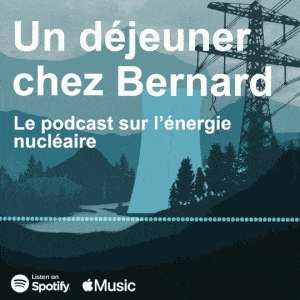Main Author : Yves Marignac
Contributors : Benjamin Dessus, Hélène Gassin, Bernard Laponche
This report is the English version, completed and re-arranged for the international audience, of the 25th issue of the periodical review Les Cahiers de Global Chance : « Nucléaire : la grande illusion – Promesses, déboires et menaces » (septembre 2008).
On this webpage : Editorial - Executive summary - Conclusion - Contents
Downloads (pdf files) (see also Contents for a more selective download) :
Full Report (10.8 Mo)
Editorial, executive summary, table of contents... (0.7 Mo)
I - Nuclear : not up to energy and climate challenges (2.1 Mo)
II - The French nuclear dream : promises for disillusion : Industrial policy (1.1 Mo), Safety (1.3 Mo), Security (1.2 Mo), Waste management (3.2 Mo), Economy (1.4 Mo), Democracy (0.5 Mo)
Conclusion, about Global Chance, about the authors (0.3 Mo)
editorial
In the context of high oil, gas and coal prices, and of ever deepening and more specific anxieties about global warming, France seems to have decided to use its EU presidency from July to December 2008 to do everything to persuade its European partners that a massive resurgence in nuclear energy is absolutely necessary. This will, of course, be to the great benefit of France’s industry. Nicolas Sarkozy has made it a key point of the ‘energy/climate package’ whose negotiation he hopes to have completed by the end of his European mandate. He has received significant support from the current President of the European Commission for this initiative, which has been widely debated across Europe.
More widely, the French President has undertaken nothing short of an international crusade on the subject, focusing in particular on Mediterranean countries such as Morocco and Algeria, to whom he has proposed active collaboration with French industry and the French Government, stressing the advantages of such cooperation in the “war on terror”. In so doing, he is relying on the global reputation which France and its industry has acquired in this field by tirelessly extolling the virtues of energy independence and the economic boost that large-scale nuclear electricity production can bring to a country’s energy system, while being environmentally harmless and perfectly safe, secure and long-lasting.
This line of argument, developed over decades by French governments both right and left, and the nuclear lobby which is closely linked to them, has managed to take hold in a France weak in independent expertise. This weakness has been deliberately maintained by the authorities and the elites, who prefer the comfort of an almost religious consensus to the debate which would inevitably be triggered by an independent and unrestricted evaluation. The French President is counting on the self-declared virtues of nuclear energy and the exemplary nature of the French experience to convince Europe, which is very divided on this issue.
In this light it seemed especially important to our association Global Chance (which includes among its members several of France’s few independent nuclear experts, and produces analyses in the fields of energy and the environment whose relevance is appreciated both in France and beyond) to offer European decision-makers and citizens a fact-based critical analysis of the French experience, so as to shed a more realistic light on the illusion of a nuclear ‘earthly paradise’ that France is trying to impose on its European partners. Global Chance thereby hopes to alert international opinion to the largely illusory nature of any plan for a massive international and European revival of nuclear power as a means of meeting the challenges of development and the environment.
First we question the capacity of such a revival, even supposing that it met no technical, political or economic obstacles, to make a decisive contribution within the required timescale to the underlying goals of the ‘energy/climate package’ : European energy security and a massive reduction in greenhouse gas emissions in the short and medium term (20% to 30% by 2020, 75% by 2050).
Second, using the example of France we investigate whether the proponents of such a revival have the industrial and economic capacity to carry it through, and the ability to contain its consequences and risks for the environment, peace and the health of the population.
This publication appears at a time when in France, more or less for the first time, the wall of silence that the authorities have erected around the more or less serious ‘incidents’ that have peppered the history of the country’s nuclear industry is beginning to crack. In the climate created by the possibility of a revival of nuclear power, the French press has taken a greater interest than usual in the various incidents that have occurred this summer (the halting of work on the Flamanville reactor site by the Autorité de Sûreté Nucléaire (ASN – the French Nuclear Safety Authority), radioactive pollution in the water table at Tricastin, a fire in the Finnish EPR etc). Both the press and public opinion have rediscovered the obscurity which in France cloaks the whole management of nuclear power’s inherent risks, and the disdain for the populace that this implies.
This is just one more reason to make this dossier, which we have entitled Nuclear power, the great illusion, widely available both to the public and to decision-makers.
Global Chance
(top)
executive summary
At a time when France is setting itself up as the political and industrial leader of a supposed European and worldwide ‘renaissance’ in nuclear power, Global Chance shows how this plan is a largely illusory response to the challenges of development and the environment. The present dossier, published to coincide with France’s European Union presidency, approaches the issue from two complementary angles.
Nuclear power : a marginal solution to the challenges of energy and climate
The first part of the dossier considers in overall terms the extent to which nuclear power is really capable of making a decisive contribution, within the necessary timescale, to the objectives of energy security and combating climate change. While these preoccupations are not new, they are looming ever larger as risks in the short term, to which an answer must be found within the next 20 years. It is against this timescale that the nuclear industry’s capacity for revival – after a long period of stagnation of which French people are generally unaware – should be measured and compared with other solutions.
Left behind as an energy source at the global level
Nuclear power was responsible for 15% of the electricity produced worldwide in 2006, contributing 6% of primary energy production but only 2.4% of final energy consumption (ie the share of consumers’ energy needs that it met). Its contribution was twice as large within the 27-member EU, at 29.5%, 13% and 5% respectively.
The nuclear industry’s relative stagnation, set against a considerable increase in electricity production, has seen its contribution to global and European electricity output fall regularly since 1995, and more rapidly since the beginning of the present century. Between 2000 and 2006, 18 times as much gas-fired, 13 times as much coal-fired, 5 times as much hydroelectric and even 3 times as much wind-powered electricity generating capacity entered service worldwide than nuclear capacity.
The level of greenhouse gas (GHG) emission reductions brought about by nuclear power depends on what power sources it is assumed to replace : its associated reductions represented 3.6% of global emissions and 10% of EU emissions in 2006, and 20% of French emissions in 2005, on the assumption that it replaced a generation mix identical to that of the overall electricity generation fleet. However, if it is assumed to have replaced a fleet of combined cycle gas plants, these savings fall to 2%, 7% and 15% respectively – and even less if renewable energy is added to the equation. Nuclear power’s effective contribution to GHG emissions reduction per unit of energy generated has been falling steadily since the 1990s.
From the energy security standpoint, while nuclear power can take the place of coal- or gas-fired electricity generation, it has only a very marginal effect upon oil consumption, which is dominated by transport. Conversely, by reason of its extremely centralised production and the particular risks that it presents, nuclear power increases energy vulnerability.
In its present state, the nuclear industry is not in a position to make a major contribution to improving energy security or to combating climate change over the coming decades. SUNBURN, the highly proactive scenario postulated by Global Chance in 2005 which involves multiplying by 50 the number of reactors to be constructed between 2005 and 2030, would result in a mere 2.9% drop in global GHG emissions and a 5% cumulative saving in fossil fuel resources by 2030, by comparison with the International Energy Agency’s (IEA’s) business-as-usual scenario. In any case, such a growth scenario, quite apart from the security, proliferation and waste management risks that it would engender, appears more and more unlikely in view of recent developments.
The marginal nature of nuclear power’s contribution, even in the most proactive scenarios, emphasises in contrast the considerable potential of other solutions. The IEA suggests a proactive scenario for reducing worldwide GHG emissions by 2050 which includes, among other proposals, a development of nuclear output from 2,800TWh a year today to 6,000TWh in 2030 and 9,000TWh in 2050. At this level, nuclear power would cut by 3.5% GHG emissions in 2050. This only represents 6% of total emission reductions in the scenario, far behind the total contribution of energy savings (54%) and even that of renewable energy (21%).
France, showcase for the limitations of nuclear power
Although marginal in global terms, nuclear power is nevertheless presented by its promoters as an effective tool for countries or regions that are ready to take full advantage of it. France, which has long relied on nuclear power to an extent unmatched elsewhere, offers the perfect example by which to measure the reality of this contribution.
France’s energy balance and GHG emission figures and projections give a full picture of the limitations of nuclear power. Despite a contribution unparalleled worldwide, with 79% of France’s electricity output in 2007, nuclear power represents just 14% of final energy consumption, far behind oil products (49%) and gas (21%). France’s energy independence is much closer to 20% than to the 50% artificially calculated in official statistics.
France consumes more oil per head of population than the European average, and more than Germany, the UK and Italy. On the other hand, its per capita GHG emissions are lower. But it appears incapable of reining in their upward trend, even though its long-term objective is to reduce them by three-quarters. This situation is connected to the weakness of policies on energy efficiency and support for new energy sources, under the influence of the priority accorded to nuclear power.
Thus the example of France shows the fatal gap between, on the one hand, the substitution of nuclear power for other energy sources and, on the other, a fundamental reform of the energy system – and raises the question of how compatible these approaches are. Analysis of official and alternative scenarios shows that pursuing its present policy would not enable France to comply either with European commitments at the 2020 timeline or with its own commitments for 2050.
Controlling energy demand, and to a lesser extent developing renewable energy, are more crucial than pursuing the nuclear programme as means to achieve France’s objectives of energy security and long-term emission reductions. In fact, the development of nuclear power actually encourages the system to evolve in various ways that are opposed to these goals – for example the impact of electric heating.
Empty promises : behind France’s nuclear dream
In the minds of many national leaders and on the international stage, the French nuclear industry nevertheless embodies an effective, safe and proven response to present-day energy problems. The second part of this dossier questions this myth, which underpins plans for a revival of the nuclear industry. After a brief résumé of the programme which France has implemented, it reconsiders that programme’s performance and, point by point, confronts the official narrative with the facts.
Industrial policy
The French nuclear programme’s image is first and foremost that of a highly successful industry, but this is a sham. The development of nuclear power in France has been marked by a succession of technological blind alleys, planning errors and all kinds of difficulties, which are generally noted and corrected without any public discussion. The need to preserve the image of control can in itself be a sufficient reason for refusing to acknowledge mistakes : it is on this ground that a 1989 EDF report concluded that it was necessary to go ahead with the reprocessing and reuse of MOX even though the whole initial justification for this, connected to the introduction of breeder reactors, had disappeared.
The French nuclear industry has frequently gambled on the wrong technologies. Prior to the failure of the breeder reactors, the French Atomic Energy Commission (Commissariat à l’Énergie Atomique – CEA) had supported the development of a fleet of natural uranium-graphite-gas (NUGG) reactors ; but EDF ultimately established its programme with American pressurised water reactor (PWR) technology, building the first 50 of its current 58 reactors under American licence. Again, France rejected centrifuging as a method of enriching uranium, instead choosing gas diffusion in the present Eurodif plant and then conducting research and development on laser technology, before Areva finally bought the centrifuging technology of its main competitor Urenco to replace Eurodif.
France has also persistently failed to bring new equipment up to the performance standards envisaged, including those for factors which are crucial to its economic justification. The official projected investment costs, for example, have consistently been lower than the actual costs subsequently acknowledged, which have never fallen as promised. Construction times and load factors have lagged badly behind the projected figures.
Even the size of the reactor fleet, far in excess of the required capacity, is based on hugely erroneous estimates : France’s electricity consumption in 2000 was oversestimated by a factor of 1.75, while the development of the global nuclear fleet was overestimated by a factor of 10 ! Export projections have also proved erroneous, with only nine reactors exported, whereas exports were supposed to match the number of plants built in France.
The EPR reactor project, by aiming to replace the fleet with this vaguely ‘evolutionary’ line of reactors, continues in the footsteps of past decisions. Above all it reflects the need to maintain capability, the loss of which, in terms both of human resources and of industrial capacity, is a major challenge for the French nuclear industry. The problems encountered with the first stages of the two EPR reactor construction sites in France and Finland exemplify this difficulty.
Safety
The development of the French nuclear industry is not without danger. The lack of major accidents conceals, from the viewpoint of safety, an evolution laden with risks. The French nuclear programme’s proponents initially claimed that a major accident was impossible, before gradually conceding that it was merely unlikely. The lessons of Three Mile Island (based on the same technology as the French PWRs) in 1979 and Chernobyl in 1986 could be incorporated only very belatedly and incompletely into a fleet three-quarters of whose units (42 out of 58) had been ordered before 1980 and completed before 1987. Even the most recent reactors have been essentially designed before 1984 – to the point that the authorities have acknowledged since 1995 that as new reactors they would no longer meet evolving safety demands.
The statistics testify to a large number of significant incidents at French reactors – around 700 to 800 a year. While the number has tended to rise in recent years, the number and seriousness of incidents classified on the International Nuclear and Radiological Event Scale (INES) has tended to fall, ranging between 50 and 100 classified incidents annually. The main criteria of the INES classification are related to the immediate seriousness of the event more than to its in-depth lessons for safety.
However, analysis of the numerous incidents over the last 20 years throws up many serious alerts covering the whole range of initial accident causes, from design faults or equipment failure to inadequate procedures and human error. In particular it illustrates the limitations of the current probabilistic approach and the worrying proliferation of generic incidents affecting one or more series of EDF’s standardised fleet. In addition to these problems, there is the factor of ageing reactors and, increasingly, the burden imposed by the demands of profitability.
The limitations of the approach to safety apply to the EPR, which closely follows the probabilistic approach and introduces new technologies such as the ‘core catcher’ whose practicability remains theoretical, implying new vulnerabilities. What is more, its concept offers no improvement in terms of the rest of the sector – the upstream and downstream stages of the fuel chain – whose safety levels, although less closely examined, remain open to question.
Security
Analysis of recent developments in terms of security, moreover, reveals an industry incapable of adapting to the post 9/11 environment. In the area of protection against malicious acts, the nuclear industry runs up against a fundamental difficulty : the credible threats have evolved so far as to exceed the load levels (mechanical, thermal etc) incorporated, essentially from a safety standpoint, into the design of the installations.
While no public evaluation exists of the consequences of an aeroplane crashing onto a reactor, public discussion has highlighted the important questions to be answered on this subject, and has revealed the vulnerability of other installations such as the irradiated fuel storage pools at La Hague. Other attack scenarios must also be taken into account. Transports are a weak security link in the nuclear chain, their vulnerability and potential for danger exacerbated by France’s opting for reprocessing.
The authorities nevertheless favour the developing of security measures rather than the industry itself adapting – or a reinforcement of secrecy rather than concrete measures. The fundamental role of secrecy in this doctrine – to the point of absurdity when it is applied to clearly visible elements – prevents the emergence of any democratic debate on this issue.
Furthermore, in terms of proliferation, France conducts itself as though it were a pyromaniac fireman. In the past, French technology has helped to develop official or unofficial military nuclear programmes (for example in Israel, Iraq and South Africa). Today, without any debate on the risks of misuse, France is negotiating nuclear cooperation agreements with numerous North African and Middle Eastern countries (from Algeria to the United Arab Emirates by way of Libya), to whom it is offering its EPR reactor. This plan exceeds both these countries’ inspection capacity and the capacity of their energy systems.
France is moreover sending a very negative signal to the world by stockpiling the separated plutonium produced by reprocessing – which, as the industry admitted only in 2006, could be used to manufacture a bomb. At the end of 2006 a total of 82.1 tonnes was being stored in France, of which 29.7 tonnes was foreign-owned. EDF’s stock of unused plutonium powder at La Hague alone represents 26 tonnes, or over 3,000 times the ‘significant quantity’ required for a bomb. The operator of the French nuclear fleet is currently the main producer of separated plutonium in the world.
Waste management
Despite the efforts recently made in this area, the figures reveal the false reasoning behind the waste management policy. The central principle of systematically reusing the ‘usable’ material (uranium and plutonium) produced by reprocessing, although in reality far from being applied, serves as the basis for a flattering but incomplete balance sheet.
On the one hand, this principle relies on perpetual move : the materials accumulated by the present fleet could never be entirely reused by that fleet ; renewal of the fleet with the same technology would only defer the problem. On the other hand, the principle enables part of the problem to be skirted : when the Government compares the inventory of waste to be stored underground at the end of the present fleet’s lifespan depending upon whether or not the nuclear fuel is reprocessed, it omits all waste associated with the reuse or storage of the 300 tonnes of plutonium and 30,000 tonnes of uranium to be transferred to a future fleet.
Far from reducing the volume of waste by a factor of four to ten as the industry claims, reprocessing complicates waste management from both a qualitative and a quantitative standpoint, by increasing the number of categories. Comparisons between storage volumes and footprints, once corrected for a set of systematic bias identified in the official evaluations, show no clear advantage in favour of reprocessing. Conversely, the complexity that it entails goes hand in hand with increased risk.
France today has no industrial solution for all its long-term radioactive wastes, which are the subject of research according to their degree of radioactivity. Large quantities of waste and ‘usable’ material of different categories are accumulating in conditioning and storage conditions which are in many cases inadequate. In the area of dismantlement, too, reality contrasts with the industry’s pretended expertise : dismantlement sites have all witnessed serious technical difficulties – sometimes unanticipated – and soaring associated costs.
Economics
The French nuclear industry’s good reputation also relies on the manipulation of economic reality. A comparison between France’s economic development over the last 40 years and that of comparable countries that have made different energy choices reveals no competitive advantage that can be attributed to nuclear power. On the contrary, it seems incapable of protecting the balance of payments. Indeed, in 2006-07 France’s energy bill saw levels of deficit comparable to those of the first and second oil crises, before the present nuclear fleet came into service.
Nuclear power’s contribution is not zero : in 2007 it is estimated to have ‘saved’ gas imports worth up to €10.7 billion. But demand for hydrocarbons has not fallen, and the energy bill reached €44.8 billion in 2007, leading to a balance of payments deficit of €39.2 billion. Conversely, the supposed financial benefits attributed to massive exports of electricity (actually a way of disposing of the French nuclear fleet’s excess capacity) have never exceeded €3.5 billion a year and are falling markedly : base-load exports are dropping while peak-rate imports, at much higher tariffs, are increasing.
Electricity price comparisons do not support the French authorities’ claim that French prices are the lowest in Europe thanks to nuclear power, even if overall they do appear to be low. Moreover, the comparison is skewed by some important factors. For example, France’s high ranking is in part due to the fact that it maintains a dominant regulated market, whose rules as regards the passing on of real costs are set by the state, which is both the regulator and the principal shareholder of EDF. Furthermore, while French households enjoy attractive tariffs, they also, as a result of the policy of promoting electricity, consume on average twice as much electricity per dwelling as the European norm (used for price comparisons).
What is more, it is known that the official reports, with very few exceptions, have systematically underestimated the real costs of nuclear power compared with the alternatives, and continue to do so – sometimes hiding behind commercial confidentiality. When EDF presented its EPR reactor project to the public debate in 2005, it had to justify the fact that its own cost estimate appeared to be 44% higher than the estimate presented by the Government in 2003 in order to include the programme in energy planning legislation. EPR’s costs – both those of EDF’s French project and those of the plant being built in Finland by Areva – have risen continually since the outset. The most recent estimates in mid-2008 were respectively €3.4 billion (for a reactor announced at €3 billion) and €5 billion (for a reactor sold at €3.3 billion).
Current discussions on the cost of reactors should not draw attention from the hidden associated costs. These of course include all the costs associated with the fuel cycle and with decommissioning, which are subject to the same distortion in the official estimates. For example, the assumed costs of reprocessing are set not at the actual level but at half that level, explicitly in order to ensure parity with the cost of the non-reprocessing option. Structural costs, although their extent is hard to establish, must also be taken into account. For example, they include the additional electricity network infrastructure costs associated with the highly centralised nature of nuclear generation, and the costs of inspection and security.
Democracy
Finally, the pursuit of the nuclear programme in France is a permanently undemocratic choice. Contrary to the image presented abroad, the French population is no more in favour of nuclear power than the European average – indeed a majority is opposed to the building of new plants. Surveys repeatedly show that the public lacks confidence in the institutional promoters of nuclear power.
This disconnect between public opinion and the thrust of policy, which is dogmatically pro-nuclear, results from an institutional system which sequesters policy from any genuine democratic control. Evaluations are carried out and key decisions taken by the country’s technocratic elite, away from any external scrutiny – in particular, a central role is played by the Corps des Mines, a state body of 700 engineers who hold almost all the key posts connected with energy.
While the overall progress in terms of information and public participation in decision-making is exerting a growing pressure, the nuclear industry in France remains a separate fiefdom, where the procedures of evaluation and public debate remain disconnected from the real decision-making processes.
(top)
conclusion
In view of its original ambitions and the considerable technical and economic efforts that it has required, the huge French nuclear programme developed between 1975 and 2000 shows a particularly disappointing balance sheet. The perennial trumpeting of “France’s energy independence” does not stand up to analysis, given that France’s per capita oil consumption in 2007 was higher than that of its large neighbours, and that the contribution of nuclear power to overall consumption was a mere 14% while oil products accounted for 49%.
Admittedly, nuclear power’s contribution does reduce France’s dependence on gas and coal, but oil dependence is by far the most restricting factor in terms of energy security. Moreover, with more than 80% of its electricity being of nuclear origin and reliant on a single technique, the pressurised water reactor, the French electricity system has created a new source of vulnerability for itself.
In overall economic terms, the ‘all electric, all nuclear’ approach which has been the cornerstone of French energy policy for the last three decades – and which continues to be so, in the face of all economic and practical reason, with the EPR reactor construction programme – has brought France no particular advantage, for example by comparison with Germany. On the contrary, the nuclear monoculture has left France a long way behind in renewable energy development and has obstructed its efforts towards energy efficiency, particularly where electricity is concerned.
Faced with the consequences of an increase in greenhouse gases, the proponents of nuclear power present it as the essential solution in that it emits much less carbon dioxide than the combustion of oil, gas or coal. But on closer inspection it becomes clear that this miracle cure is nothing of the sort. It is true that nuclear electricity generation contributes to the reduction of greenhouse gas emissions – but even in the extreme case of France, this reduction amounts to at most an estimated 15-20% of total emissions. While this figure is not negligible, it needs to be balanced against all the risks posed, and pollution generated, by the whole complex and dangerous nuclear power system, with its power stations, its fuel plants and its radioactive material transports – both now and in the long term (dismantling of the installations, management of the radioactive waste).
Nuclear power is liable to suffer serious accidents that may affect extensive areas for long periods of time. No satisfactory solution has been found for the management of long-term waste. Finally, proliferation remains a major risk for global security and it is dishonest to maintain that a country can be equipped with civil power stations without a military use being possible.
Moreover, nuclear power can only contribute to the production of electricity, which (adding all sources together) represents only around 20% of a developed country’s end-user energy consumption. The remainder comes from the petrol and diesel burned in cars and lorries, the oil or gas used to heat buildings and power industrial production – and also from biomass and solar energy (of course hydro and wind power produce electricity).
The unavoidable fight against greenhouse gas emissions therefore requires, first of all, a policy of energy saving and research into greater energy efficiency. Next, it calls for a greater reliance on renewable energy.
The continuation of present-day global energy consumption trends runs up against insurmountable obstacles and leads to a developmental impasse, accentuating the inequalities between rich and poor countries and contributing to social breakdown. Economic and social development can only be held back, if not made impossible, by energy insecurity (in terms of physical supply faced with geopolitical constraints, rising prices, increasing scarcity of resources in the medium term, and risks both technological and posed by external stresses of all kinds) and by the degradation of the local environment (by pollution and accidents) and the global one (through climate change). The rising price of oil is already wrecking the most fragile economies. Besides, ‘business as usual’ scenarios of the energy future clearly highlight the political, economic and environmental impasse to which they lead.
Energy security and environmental constraints pose a considerable challenge for social and economic development on a global scale. The limiting of energy consumption is now the policy most urgently in need of adoption, in that it has the greatest potential to develop, is applicable to all sectors and in every country, is the best instrument with which to combat climate change, and can help slow down the depletion of fossil fuel resources and ensure that a growing proportion of energy demand is met by renewable energy. It can also contribute to economic development by reducing expenditure on energy and by creating new business activities and employment. It is a key imperative of energy and economic policy.
This fundamental change in the energy paradigm which gives priority to demand rather than to supply profoundly alters the citizen’s relationship with the energy system. The need to provide an ‘energy service’ instead of an ‘energy supply’ brings new actors to the fore : businesses, communities, households, and professionals in the construction, transport and manufacturing industries, in agriculture and in the service sector. Cities and local authorities become key drivers and promoters of these new policies.
By applying such a strategy, industrialised countries can reduce their energy consumption to a significant degree. Developing countries need to increase theirs, but they can do so at a much slower rate than that undergone by rich countries in the past, with the damaging consequences we know all too well. For most countries, including major energy producers, the reduction of energy consumption will represent their main national energy resource for the decades to come.
Europe can play a lead role in promoting this policy : indeed both its energy security and the fight against climate change oblige it to. The March 2007 European Summit’s decisions on the “three 20 per cents” (energy efficiency, renewable energy and greenhouse gas emissions) and the “energy package” presented by the European Commission are an encouraging signal within the European Union. But the “burden sharing” between Member States remains to be organised, and this will be the touchstone of their individual political will.
In this context, and considering what is at stake in terms of the climate risk, energy security and economic and social development, nuclear power’s real contribution will continue to be marginal for Europe. Conversely, the physical and geopolitical risks that further expansion of the technology in its present state would entail are so great that the balance of benefits and drawbacks is very clearly against such an expansion. Moreover, nuclear power requires massive centralisation of the energy system, based on high-output power stations, whereas technological progress is increasingly concerned with an energy system based on decentralised actions and initiatives in the fields of energy efficiency, renewable energy and combined heat, cooling and power production.
(top)
contents
Nuclear : not up to energy and climate challenges
Nuclear : a marginal solution to the challenges of energy and climate
Focus 01 – Electricity savings versus nuclear revival
France, showcase for the limitations of nuclear power
Focus 02 – Electric heating – not so virtuous
The French nuclear dream : promises for disillusion
Basics – The nuclear industry in France – an overview
Industrial policy
Beyond the ideal image of a highly successful industry
Focus 03 – From planning to structural mishap
Focus 04 – The loss of competencies
Focus 05 – The problems of EPR projects
Safety
A risky evolution
Focus 06 – 1986-2006 : twenty years of significant incidents in France
Focus 07 – The EPR, supposed improvements versus new vulnerabilities
Focus 08 – Is France prepared for a major accident ?
Focus 09 – Growing safety concerns in the fuel chain
Focus 10 – Pressure on performance and safety
Security
An industry incapable of adapting to the post-9/11 world
Focus 11 – Nuclear reactors as ‘pre-deployed weapons’
Focus 12 – Transports, a weak link in the nuclear chain
France, a pyromaniac fireman of proliferation
Focus 13 – Plutonium stockpiling, a signal for proliferation
Waste management
The failure of the “rationale” waste management policy
Focus 14 – Long-lived waste : still an unsolved problem
Focus 15 – The piling-up of nuclear materials and radioactive waste
Focus 16 – Alongside waste, the problem of dismantlement
Economy
Twisting global economics
Focus 17 – From “too cheap to meter” to too expensive to tell ?
Focus 18 – EPR costs : high and rising
Side economics : downplaying associated costs
Democracy
A long-lasting undemocratic choice
(top)
 Global Chance
Une expertise indépendante sur la transition énergétique depuis 1992
Global Chance
Une expertise indépendante sur la transition énergétique depuis 1992
 October 2008, final version
October 2008, final version




